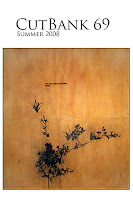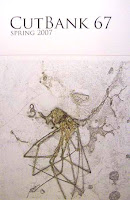
Parlor Press, 2006
Reviewed by Andy Grace
The poems in Adam Clay’s first book, The Wash have a porcelain-like quality about them, not in the sense of fragility, but in that they are at once common and luminous. Here is the entirety of his poem “Elegy”:
I took cold water from the river in my hands, drank,
And looked down to see a rock black with the memory of my face.
This poem, which appears early on in the collection, acts as a precursor to the book’s central piece “Elegy for the Self-Portrait,” a series of seventeen unnumbered lyrics, none longer than ten lines. Brevity is obviously a quality that Clay values. He even goes as far as playfully tempting his reader to question the slightness of his work in the opening line to “Dominion”: “Things in miniature form seem oddly attainable.” But these poems resist certainty upon initial interpretation, even those that are two lines long, or even one. Through turns of syntax and logic, along with the accrual of meaning of certain images throughout the journey of the book, Clay manages to create a complexity of project, while maintaining simplicity of language. Along with Saskia Hamilton, the contemporary poet whom to my mind Clay is most comparable, Clay often writes in a high-lyric minimalism in line with the best hyper-brief contemporary American poems, like W.S. Merwin’s own “Elegy,” Charles Wright’s “Bygones” and countless poems by Robert Grenier.
Throughout the book, water and avian imagery are the foremost subjects of Clay’s attention. The voice of the naturalist appears repeatedly, both in Clay’s own observations of nature and some appropriated from other texts, primarily travel journals from the 19th century. But the naturalism of The Wash is anything but a straightforward account of the exterior world. Here is an excerpt from the book’s opening poem “[Caught No Fish]”:
Caught no fish last night or night before Last,
Shot an Autumnal Warbler […]
The Warbler (I was in My Dream)
Gained the Power of Observation, and If My Eyes
Did not err, my Own face as Seen
Through the Bird’s was Filled with the Glow
Of A Church Bell ringing. Once I killed a Fish Crow
And hundreds flew to him and appeared as if about to Carry him off.
The presence of italics and such archaisms as the capitalization of nouns made me think that at least some of the language was found text. There are no endnotes in The Wash, but a Google search of some of the phrases of the poem show, or at least strongly suggest, that language has been appropriated from elsewhere. “Caught no fish last night” appears to be from a journal of Asbury C. Jaquess, a deckhand on Davy Crockett’s journey to New Orleans in 1834: “We caught no fish last night but Mike who is the steward of the two boats caught a couple of beautiful chickens for us.” “Shot an Autumnal Warbler” is from Audubon’s journal entry from October 12th, 1820 on the Ohio River: “Shot an Autumnal Warbler as Mr. A. Wilson is pleased to designate the young of the Yellow rumpled Warbler [...]. “Killed a Fish Crow” appears to be from the 1874 diary of ornithologist Edwin I. Shores: “My first shot at Ft. Capron killed a Fish Crow and a Turkey Buzzard.” “Church Bell ringing” (the phrase that I am least sure is appropriated, but Audubon has appeared earlier, and Clay has Southern roots) could be from Audubon’s journal of his time in New Orleans, 1821: “[…] the Church Bell ringing [and] the Billiard Balls Knocking, the Guns heard all around.” The collage of 19th century language, woven together by Clay’s own voice creates a text that attempts to reconcile self-recognition through nature with the simultaneous destruction of nature. The speaker of “[Caught No Fish]” dreams that the bird he has killed has acquired human powers of observation, and, beholding his killer, sees in his visage a holy luminosity.
This imagined, self-aggrandizing example of the pathetic fallacy is quickly countered by the last sentence, which describes a collective mourning of birds over one of their own, almost an avian laying-on-of-hands. These two contradictory elevations, first of the killer, then of the fallen, speak to the complications of self-portraiture through nature. In her blurb for the book, Joyelle McSweeney claims that Clay is a “naturalist who knows himself excluded from Nature’s mirror,” which is not to say that Clay does not test himself in this mirror, but that he acknowledges that whatever appears is generated from his own psyche. Nature can do no more or less than obey its own laws, or, as Clay puts it,
A male bird cannot help but sing
A male bird cannot help but sing
A male bird cannot help but sing
and softly add to the confusion.
This anti-pastoral strain in Clay’s work, coupled with an obvious passion for Nature, makes the poems in this book seem both Romantic and utterly contemporary.
What makes Clay’s nature poems experimental is not any linguistic innovation or visual formatting of the work, but rather his approach to narrative. Here is where Clay’s talents most overlap with Saskia Hamilton’s: both of them establish repeated images that accrue meaning throughout a book. Each discrete poem is dependant on the unified whole of the piece. Which is why rereading seems to be crucial in the understanding of both poets. The resonance of the image of a river on page early in the book is enhanced/undermined by the image of a river on towards the end. There are poems in The Wash that do feel too slight, that is, if you consider them out of the context of the book. But considered as links in a web, these poems are essential connective tissue: if you took them out, the web would go slack.
This long-view of narrative (as in an emotional journey, not a storyline) over the course of the book contrasts with the unconventional narratives in many of the individual poems, which frequently use non-sequitur and fragmentation. Take the ninth section of “Elegy for the Self-Portrait”:
The trees still bent from this winter’s ice.
The joke of ten thousand years retreats
to the debris of its own punchline.
Tomorrow figures to be the passion of dirt.
Today is a bucket around which this house is built.
The exact situation is difficult to determine. We know it is late winter, perhaps early spring. The defeated posture of the ice-weighted trees becomes bleaker with the next two lines. Whatever “the joke” is, it seems that the joke has been on us, and its retreat into debris is ominous. The fourth line suggests two opposite readings: “the passion of dirt” could mean fecundity/regeneration, or its opposite, which is the embrace of dirt, e.g. death. Finally, we are given a line that is, unlike the others, wholly of the present, which is centered on a homely, utilitarian image, the bucket, around which we organize our lives. This poem stands on its own: it is a poem that attempts to situate a mind in time. The past has chosen to keep its secret, the future is ambiguous is its transformations, but the present, bucket-like temporary container as it is, can be the only place of habitation.
But then consider how the poem resonates with the previous imagery in the book. The section immediately preceding the one quoted above reads simply
Ten laughs in the space where one should be.
This laughter could be that of the past, lording over us the private nature of all of its punchlines. Given the context of the poem that follows it, these ten laughs are haunting. That they occupy a space where only one should be make the reverberations of this retreated joke overwhelming. Thus the necessity of rereading Clay’s work: sometimes the echo comes before the utterance. And the echoes do not end: in the first stanza of “Bones and Wandering,” an early poem in the book, laughter is once again portrayed as an ill omen:
The grave of light is now underwater. Scoundrels curve
Along the riverside and laugh so loud it remains night
For three days.
This laughter serves to cover up
Their true purpose: searching to remedy the curse
Of their contorted faces.
And again in the first two lines of “Tiny Eclipse”:
Born into a beehive of clarity, bedtime and endtime
Are the laugh inside a shotgun barrel
In the first example, laughter once more is related negatively to time: it brings on a three-day darkness meant to temporarily mask ugliness. In the second example, laughter is the symbol of an immanent violence. So by the time we reach “Ten laughs in the space where one should be,” we know, or, at least, we suspect, that this does not does not describe a moment of sudden happiness, made all the more intense for its not being expected. Thus the subsequent retreated “joke” of ten thousand years can connote nothing to the reader but an irrevocable rescinding of an era, one that leaves us with only our capacity for work and tolerance of uncertainty to get us through.
In the imagistic vocabulary of the book, Clay has managed to turn laughter into a harbinger of loss, the aural indicator of endtime. The arc of the book is constructed in this and other repeated images: I could trace similar through-lines with birds, rivers, pianos, reflections, bones, etc. This mode of narrative through repetition of imagery is like setting stepping stones across a river: they are the sure ground under which the various concerns of the book (the problematics of naturalism, the irresistible urge towards and impossibility of self-portraiture, how language can be at once spare and innovative) can pass under.
Clay has entitled the opening section of the book “The Most Careful Music” and the poems live up to that label. There is hardly a willful phrase to be found here. While the physical scale of the poems in The Wash is often small, Clay has written a formidable first book that demands rereading.
**
Adam Clay's poems have appeared in Denver Quarterly, The Iowa Review, Barrow Street, Black Warrior Review, Fascicle, CutBank, New Orleans Review, Conduit, Octopus Magazine, Free Verse, and elsewhere. A chapbook, Canoe, is available from horse less press. With Matt Henriksen, he edits TYPO Magazine. Born and raised in Mississippi, he holds an MFA from the University of Arkansas and an MA from The Center for Writers at the University of Southern Mississippi. He now lives in Kalamazoo, Michigan, with his wife, Kimberely.
**
Andy Grace is currently a Stegner Fellow at Stanford University and his poems have appeared in Poetry magazine, Denver Quarterly, Boston Review, Poetry Daily, TriQuarterly, Iowa Review, and Crab Orchard Review among others. His first book A Belonging Field is out from Salt Publishing.




